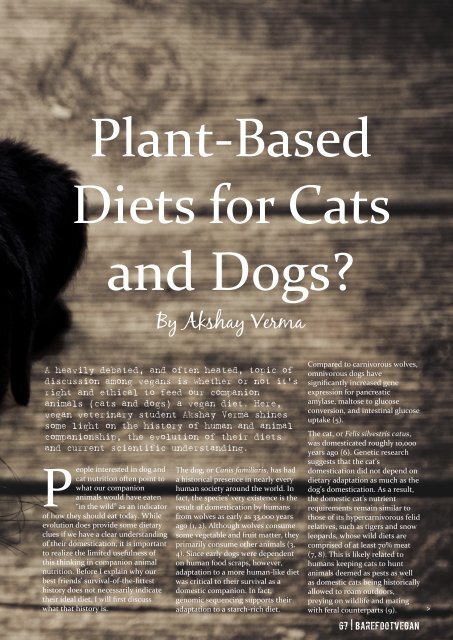barefoot vegan sept_oct issue.pdf
- No tags were found...
Create successful ePaper yourself
Turn your PDF publications into a flip-book with our unique Google optimized e-Paper software.
Plant-Based<br />
Diets for Cats<br />
and Dogs?<br />
By Akshay Verma<br />
A heavily debated, and often heated, topic of<br />
discussion among <strong>vegan</strong>s is whether or not it’s<br />
right and ethical to feed our companion<br />
animals (cats and dogs) a <strong>vegan</strong> diet. Here,<br />
<strong>vegan</strong> veterinary student Akshay Verma shines<br />
some light on the history of human and animal<br />
companionship, the evolution of their diets<br />
and current scientific understanding.<br />
P<br />
eople interested in dog and<br />
cat nutrition often point to<br />
what our companion<br />
animals would have eaten<br />
“in the wild” as an indicator<br />
of how they should eat today. While<br />
evolution does provide some dietary<br />
clues if we have a clear understanding<br />
of their domestication, it is important<br />
to realize the limited usefulness of<br />
this thinking in companion animal<br />
nutrition. Before I explain why our<br />
best friends’ survival-of-the-fittest<br />
history does not necessarily indicate<br />
their ideal diet, I will first discuss<br />
what that history is.<br />
The dog, or Canis familiaris, has had<br />
a historical presence in nearly every<br />
human society around the world. In<br />
fact, the species’ very existence is the<br />
result of domestication by humans<br />
from wolves as early as 33,000 years<br />
ago (1, 2). Although wolves consume<br />
some vegetable and fruit matter, they<br />
primarily consume other animals (3,<br />
4). Since early dogs were dependent<br />
on human food scraps, however,<br />
adaptation to a more human-like diet<br />
was critical to their survival as a<br />
domestic companion. In fact,<br />
genomic sequencing supports their<br />
adaptation to a starch-rich diet.<br />
Compared to carnivorous wolves,<br />
omnivorous dogs have<br />
significantly increased gene<br />
expression for pancreatic<br />
amylase, maltose to glucose<br />
conversion, and intestinal glucose<br />
uptake (5).<br />
The cat, or Felis silvestris catus,<br />
was domesticated roughly 10,000<br />
years ago (6). Genetic research<br />
suggests that the cat’s<br />
domestication did not depend on<br />
dietary adaptation as much as the<br />
dog’s domestication. As a result,<br />
the domestic cat’s nutrient<br />
requirements remain similar to<br />
those of its hypercarnivorous felid<br />
relatives, such as tigers and snow<br />
leopards, whose wild diets are<br />
comprised of at least 70% meat<br />
(7, 8). This is likely related to<br />
humans keeping cats to hunt<br />
animals deemed as pests as well<br />
as domestic cats being historically<br />
allowed to roam outdoors,<br />
preying on wildlife and mating<br />
with feral counterparts (9).<br />
67 | BarefootVegan<br />
>





